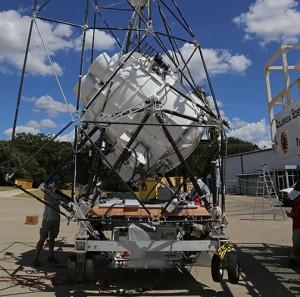Tigers of the Week: Princeton’s SPIDER Scientific Ballooning Project Team
While other Princetonians were marking the start of 2015 at holiday parties, a team of stalwart scientists led by assistant professor of physics William Jones ’98 gathered in Antarctica to launch a research balloon that will collect information about gravitational waves from about 110,000 feet above the Earth.
The project, called SPIDER (for “Suborbital Polarimeter for Inflation, Dust and the Epoch of Reionization”), could provide new insights about the early stages of the Big Bang. But first, the high-tech payload of telescopes needed to reach its perch in the stratosphere. After threatening weather cleared, SPIDER was able to lift off on Jan. 1. News of the successful launch was featured in The New York Times. Associate research scholar Zigmund Kermish ’03 also described the researchers’ experience on theproject blog.
In addition to Kermish and Jones, the 21-member SPIDER team includes alumni John Ruhl *93, a professor of physics and astronomy at Case Western Reserve University; C. Barth Netterfield *95, a professor of astronomy at the University of Toronto; Aurelien Fraisse *10, an associate research scholar at Princeton; and Jon Gudmundsson *14, a postdoctoral research associate at Princeton.
The SPIDER launch initially was slated for December 2013, but a 16-day federal government shutdown in October 2013 forced a one-year delay. Jones told PAW at the time that the postponement stemmed from “a terrible confluence of politics, our artificial fiscal calendar, and the very real reality of the Antarctic climate.”
The story appears headed for a happy ending. Each of the subsystems was operating as planned shortly after liftoff, according to Kermish’s post. “Right now, we’re all an interesting amalgam of exhausted, thrilled, and wired by caffeine, as we watch the balloon disappear from view,” he wrote. “I can’t think of a better way to ring in the New Year.”












No responses yet